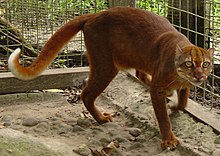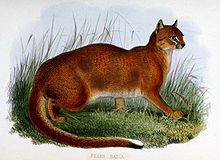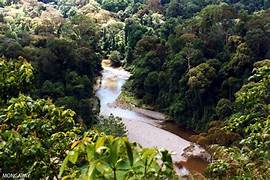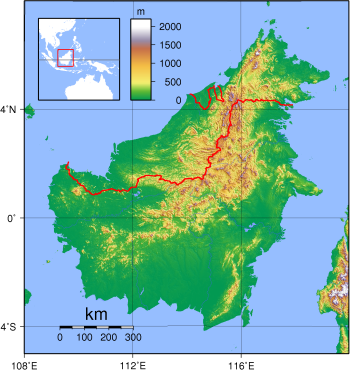Meet a cat that you have most likely never met before. The bay cat, also carrying the monikers of Borneo Bay cat and Bornean Bay cat, lives only on the island of Borneo. The cat’s latin name, Catopuma badia, identifies a small wild cat native to the island.
This cat, relatively rare, joins the list of endangered animals. The estimate tells us that, since 2002, the likely total of these animals is fewer than 2,500 mature individuals. Even in the best habitat, the cat seems to occur at a somewhat low density.
This Elusive Cat’s Rarity Made It Hard To Study
Because this cat is so elusive, it took more than a century before researchers could study a live bay cat. The cat received its name in 1874, based on a skull and torn skin, sent to England by Alfred Russel Wallace, the famous naturalist.
In 1992, a captured bay cat gave naturalists their first opportunity to study one. Because they prove so difficult to locate, researchers know very little about how these cats live.

In 1874, John Edward Gray proposed that the scientific name for this cat become Felis badia. From the skin and skull collected by Alfred Russel Wallace, the cat at first was believed to be a kitten of an Asian golden cat.
Then, in 1932, Reginald Innes Pocock placed the species in the genus Badiofelis. Then, in 1978, the animal became placed in the genus Catopuma.
Then, in 1992, when tissue and blood samples taken from a female brought to the Sarawak Museum, the close relationship between the two species became confirmed. It turned out that the two species had become separated from a common ancestor some 4.9 to 5.3 million years ago, long before Borneo became geologically separated from mainland Asia.
Then, in 2006, because of a close relationship between the bay cat, the Asian golden cat, and the marbled cat, all three species became grouped in the genus Pardofelis.
Characteristics Of The Cat
The fur of the bay cat appears a bright chestnut color, though paler underneath. Limbs and tail show as rather paler and more reddish. This cat has rounded ears, covered with short, blackish-brown fur outside, paler brown within, and with a narrow brown margin.

The very long tail tapers at the end, and has a white central streak that occupys the rear half of the lower side. This streak gradually becomes wider and a purer white towards the tip. Here you would see a small black spot at the upper end of the tail tip.
The short, rounded head has a dark greyish-brown color, and has two dark stripes that originate from the corner of each eye. The back of the head has a dark M-shaped marking. The backs of the ears carry a solid grey color.
Underside of the chin shows as white, and the cat has two faint brown stripes on the cheeks. Because of its rarity, only 12 specimens became measured between 1874 and 2004. The head-to-body length varied from 19.5 to 26.4 inches with 11.8 to 15.9 inch long tails.
Adult weight estimate comes in at 6.6 to 8.8 pounds. However, this measurement becomes an estimate, since too few living specimens have been obtained. Therefore, the estimate comes off as unreliable.
This cat, about the size of a normal house cat, has also shown a second color phase of dark,bluish slate-grey fur. Could this variation possibly be because the photos taken of the cat show the feline in night light, and the color might be muted?
Habitat And Distribution
In the 19th century, only seven bay cat skins surfaced, and it wasn’t until 1992 that a live animal was trapped, the animal on the verge of death. By the mid-1990s, sightings reported in Gunung Palung National Park and the upper Kapuas River in West Kalimantan indicated two concentrations of the cat.
These cats’ habitat occurred in swamp forests and lowland forest to hill forests up to 1600 feet. It inhabits dense tropical forests and rocky limestone outcrops. A few appeared near rivers, or near the coast. Almost all recent records come from proximity to water bodies.
From July 2008 to January 2009, a camera trapping survey in the northwestern part of Sabah’s Deramakot Forest Reserve netted one photo of a male bay cat. The record expanded the known range of the Bay cat to the north.

The bay cat, photographed off-trail in seven of eight records, shows that it tends to avoid logged areas. During a repeated camera survey in Kalabakan Forest Reserve in 2018, the cat appeared in just eight of 74 locations during more than 7,200 camera trap days. Elusive? Rare? Absolutely.
Ecology And Behavior
This cat, secretive and noctournal, plus the low number of the animal, may constitute an important cause for sighting rarity. During 2003 to 2006, camera trapping surveys yielded only one photo of a bay cat in 5,034 trap nights.
A local animal collector near Lachau, Sarawak, claimed he accidentally trapped two bay cats at two different times in December of 2003. He claimed the cats entered his aviary and attacked the pheasants. One cat died in captivity, and the other was released.
Though very little information exists about this cat, its diet may include small rodents, carrion, birds, and monkeys.
As with other Bornean species, the cat’s population suffers from the palm oil industry. Farmers cut down natural forests and plant oil palm plantations. By doing so, they destroy suitable habitat for the cat and for many other animals. Several studies conclude that the bay cat does not live in oil palm plantations.
What About Domestication?
Humans have not domesticated this cat. It would not make a good pet, as the animal is incredibly shy. You can’t own one, anyway, as the population is declining and every individual becomes important for helping the species survive.
No bay cat has become the resident of any zoo.
As no one can observe them, nothing is known about their reproductive behavior.
Threats
The bay cat, forest-dependent, becomes increasingly threatened by habitat destruction. The island has one of the world’s highest deforestation rates. Habitat loss due to commercial logging and rising oil palm plantations pose the greatest threat for this cat.
In the mid-1980s, forests still covered almost 3/4 of the island’s area. By 2005, only 52% of Borneo still had forests. Human settlement also accounts for loss of both forests and land.
Poaching for the illegal wildlife trade also offers a significant threat, as the cats become captured in the wild for trade for their skins.
Conclusion
Hopefully, conservation efforts will prove effective. Listed as endangered, the bay cat receives full protection by national legislation, covering most of its range. In Kalimantan, Sabah, and Sarawak, hunting and trade will not occur legally.
Because its rarity causes it to become one of the least studied of the world’s wild cats. conservation actions become somewhat hampered.
Enjoy the videos included here to get a glimpse of this animal.
References I used for this post:
en.wikipedia.org/wiki/Bay_cat#Distribution_and_habitat animals.net/bay-cat/ wildcatconservation.org/wild-cats/asia/borneo-bay-cat/ animalia.bio/bay-cat

